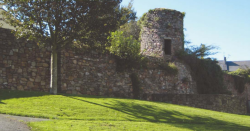INSTITUT SUPERIEUR D'ANTHROPOLOGIE
INSTITUTE OF ANTHROPOLOGY
ONLINE COURSES / COURS A DISTANCE
FALL TERM : OCTOBER 2013
REGISTER NOW
POLOGNE - Czelin - Crematory pit and urn grave from the 1st/2nd century AD have been discovered by archaeologists during excavations in the Roman period cemetery in Czelin (Zachodniopomorskie). Bartłomiej Rogalski from the National Museum in Szczecin , who conducts research, said in an interview with PAP that the form of the clay urn and the specific "toothed wheel" decorating technique are typical for the Elbe area, lying west of the Oder . According to Rogalski, the ornament on the vessel is in turn typical for the Przeworsk culture , which at that time occupied territories of Wielkopolska and Silesia. "This conglomerate of various cultural trends is symptomatic of Lubusz group" - added Rogalski. In the second, pit burial, in addition to bone archaeologists have also found pieces of similarly ornamented pottery. In the immediate vicinity of the burials, archaeologists have discovered the complex of furnaces and setts. Researchers believe that this could be the place of preparation for burial ceremonies and other rituals. According to Rogalski, burials belong to the Lubusz group, which from the 1st to the 3rd century AD occupied Lower Nadodrze , Wkra Land, Pyrzyce Land and Mysliborskie Lakes. Lubusz group is poorly explored archaeologically and it characteristics still await clear definition, added Rogalski. Since 2004, archaeologists discovered nearly 100 objects in the cemetery in Czelin, including about 50 burials, as well as traces of the devices associated with the operation of the cemetery . Noteworthy urn graves include burials of warriors containing the armour. Last year, archaeologists found three graves of warriors that contained shield fittings and spearheads. Also in the cemetery in Czelin, they found the second tomb of a rider buried with a spur. "This is a unique find, as monuments connected with horse riding are a rare discovery. Cavalry was a marginal formation in the armies of the barbaric tribes" - said Rogalski . According to Rogalski, objects found in Czelin indicate a very high political importance of the local tribes in the contemporary world. As he said, in one of the tombs archaeologists found a double-edged sword, made in the Roman Empire. Earlier discoveries include a Roman bronze vessel, made in Naples area, and an exclusive buckle for garments made in the bronze workshops of Noricum and Pannonia. Rogalski believes that the luxury items did not arrive to the Oder area directly from the Roman Empire, but were probably imported from the territory of the Marcomanni in today's Czech Republic.
http://www.naukawpolsce.pap.pl/en/news/news,396912,archaeologists-discover-burials-from-the-roman-period-in-czelin.html
IRLANDE –  Wexford - In Wexford you have massive Anglo Norman walls, 1.2km of them, from the south of the town, Barrack Street, King Street, Bride Street, the Theatre Royal and Rowe Street and down to Selskar. The exhibition, compiled by Stafford McLoughlin Archaelogy and funded by the planning department at Wexford County Council, Wexford Borough Council and the Heritage Council, chronicles the town's archaeology in clear, concise terms – it is designed to be easily understood and digested, a sort of rough guide spanning thousands of years in a few thousand words and pictures. Asked what the most exciting of her finds has been, she is enthusiastic about medieval finds beneath the back of the Thomas Moore Tavern made during its redevelopment. 'The preservation was fantastic . We found barrel lids, planks and posts of alder, hazel, birch and oak,' she said. Through dendochronology of the barrel lids, the finds were dated to 1190. The site was dug in 2007 before the re-deevelopment of the Thomas Moore and shows how people lived – everyday objects, even the preserved remains of shoes, made extraordinary by the 800-plus years they had laid undisturbed in the damp ground.
Wexford - In Wexford you have massive Anglo Norman walls, 1.2km of them, from the south of the town, Barrack Street, King Street, Bride Street, the Theatre Royal and Rowe Street and down to Selskar. The exhibition, compiled by Stafford McLoughlin Archaelogy and funded by the planning department at Wexford County Council, Wexford Borough Council and the Heritage Council, chronicles the town's archaeology in clear, concise terms – it is designed to be easily understood and digested, a sort of rough guide spanning thousands of years in a few thousand words and pictures. Asked what the most exciting of her finds has been, she is enthusiastic about medieval finds beneath the back of the Thomas Moore Tavern made during its redevelopment. 'The preservation was fantastic . We found barrel lids, planks and posts of alder, hazel, birch and oak,' she said. Through dendochronology of the barrel lids, the finds were dated to 1190. The site was dug in 2007 before the re-deevelopment of the Thomas Moore and shows how people lived – everyday objects, even the preserved remains of shoes, made extraordinary by the 800-plus years they had laid undisturbed in the damp ground.
http://www.independent.ie/regionals/wexfordpeople/news/archaeology-uncovers-life-in-walled-town-29547483.html
CHINE –  Dunhuang - As a key stopover on the ancient Silk Road, the Dunhuang Mogao Grottoes in Northwest China’s Gansu Province have major historical significance. Now, a new technique has been adopted to preserve the ancient murals in the caves. What’s more, it can also help visitors see the murals in all their original glory. The ancient murals in the Dunhuang Mogao Grottoes are ageing like human beings. More than a thousand years since they were painted on the surface of the caves, many of them have become very hard to identify. However, with the help of a multi-spectral imaging technique, the original colourful paintings can now easily be seen. "We can’t see any paintings on this wall, but by using the multi-spectral imaging technique, all the layers of paintings can be ’reproduced’," said Su Bomin, director of Conservation Institute of Dunhuang. Using this technique, archaeologists discovered several paintings featuring exquisite costumes. This technique also helps researchers analyse the painting skills and characteristics of the murals. The Dunhuang Mogao Grottoes are home to more than two thousand sculptures and 45-thousand square meters of murals across 735 caves. Hopefully the multi-spectral imaging technique will encourage the research and preservation of the unique site.
Dunhuang - As a key stopover on the ancient Silk Road, the Dunhuang Mogao Grottoes in Northwest China’s Gansu Province have major historical significance. Now, a new technique has been adopted to preserve the ancient murals in the caves. What’s more, it can also help visitors see the murals in all their original glory. The ancient murals in the Dunhuang Mogao Grottoes are ageing like human beings. More than a thousand years since they were painted on the surface of the caves, many of them have become very hard to identify. However, with the help of a multi-spectral imaging technique, the original colourful paintings can now easily be seen. "We can’t see any paintings on this wall, but by using the multi-spectral imaging technique, all the layers of paintings can be ’reproduced’," said Su Bomin, director of Conservation Institute of Dunhuang. Using this technique, archaeologists discovered several paintings featuring exquisite costumes. This technique also helps researchers analyse the painting skills and characteristics of the murals. The Dunhuang Mogao Grottoes are home to more than two thousand sculptures and 45-thousand square meters of murals across 735 caves. Hopefully the multi-spectral imaging technique will encourage the research and preservation of the unique site.
http://www.kaogu.cn/en/detail.asp?ProductID=4375